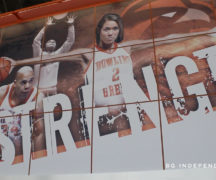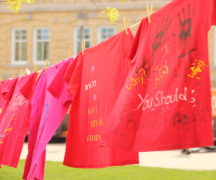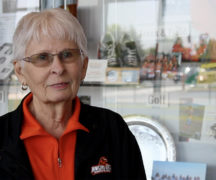By JULIE CARLE
BG Independent News
Growing up in Napoleon, Ohio, in the 1940s and ’50s, Marcia Saneholtz, was the only girl who was playing baseball and football in the streets with the neighborhood boys. She collected baseball cards, followed men’s sports because women’s sports weren’t really a thing, and was a GAA (Girls Athletic Association) All Star in high school.
By the time she went to college at Bowling Green State University, pre-Title IX, the only career choice for the sports-loving female was to be a physical education teacher. She did that for several years following her 1964 graduation and then went on to have an illustrious career as a senior woman administrator for the Washington State University intercollegiate athletics program, where she helped usher in Title IX changes.
A recognized and long-time advocate for gender equity in sports, Saneholtz was the featured guest for the Richard A. Maxwell Sport Media Project at BGSU on Wednesday.
BGSU’s interim Director of Athletics Stacy Kosciak facilitated the conversation celebrating 50 years of Title IX, the federal civil rights law that has been credited with profoundly changing education in the United States by barring sex discrimination in the nation’s schools. They discussed topics that ranged from Saneholtz’s experiences on BGSU’s first women’s intercollegiate basketball team to her path into intercollegiate athletics and
the impact of Title IX on her career.
Saneholtz has been passionate about sports her entire life. She recalled a story her mother told: “A neighbor woman asked if it was healthy for me to be playing with the boys to which my mother responded, ‘That’s what she loves to do; I don’t see anything wrong with it.’ My parents allowed me to be who I was. I credit them for how I proceeded in life.”
Her BGSU student-athlete experience from 1962-64 was great, but she admitted it was because in high school intramural sports were the only option available to girls.
Women’s sports at the time were “very rudimentary compared to today. I remember we played Ohio State and Michigan, but we went (to the games) on a school bus or by car. We didn’t have uniforms; we wore our physical education shorts, white blouses and pinnies over top,” she said.
“I don’t remember if we won or lost or what the scores were, but I do remember that those were big opportunities. It was so exciting because we’d never had these kind of experiences that now, young men and women take for granted.”
Saneholtz has been at the forefront of changes in sports for women.
Though Title IX passed in 1972, high schools and universities were slow in implementing changes.
Title IX first impacted her career path when she and her family were living in Seattle. She had gotten involved in coaching for the Seattle parks and recreation programs. Ruth Smith, who was second in command in the rec program, suggested that Saneholtz consider becoming an official for high school girls sports, which were rapidly expanding because of the legislation.
“She gave me the first opportunity to experience what Title IX would give women,” Saneholtz said.
First she was a Seattle-area volleyball and basketball official with national rankings. From there, she became head of the Seattle officiating organization, moved on to lead the state organization and eventually headed the national rating team.
“That is when I realized I liked administration. I always thought I’d go back to be a PE teacher,” she said. Instead, she went on to earn a master’s degree in sport administration.
In 1979, she was hired as the assistant athletic director for the women’s program at Washington State University and three years later the men’s and women’s programs merged. While at WSU, Saneholtz supervised six sports and several support areas, including athletic medicine and event and facility operations. She retired in 2007 as senior associate athletic director.
Throughout her tenure at WSU, she focused on providing equitable services and opportunities to male and female athletes.
“Men’s athletics set the standard. They’d been around for a long time. I tried to facilitate all of our athletes to have the same quality experience, whatever that might be. The bottomline was that the women had to have the same opportunities and services as the men, including access to support services,” she said.
She received numerous awards and accolades over the years for her efforts. The National Association of College Women Athletic Administrators (NACWAA) named her Administrator of the year in 1997 and presented her with the Lifetime Achievement Award in 2010. She earned the National Association for Girls and Women in Sports (NAGWS) Pathfinder Award in 2001 and was named the Woman of Distinction at Washington State in 2003.
BGSU inducted the 1962-64 women’s basketball player into the Athletics Hall of Fame in 2015 for contributions to college athletics that reach far beyond her playing days. Napoleon High School also inducted her into the Distinguished Alumni Hall of Fame.
When asked about the most rewarding part of her career, Saneholtz said, “Every job is about the people, the relationships and who you work with. I always enjoyed seeing student-athletes grow and develop, and how they take advantage of the experience and the leave more mature, with a better perspective about life and how they want to move forward.”
Addressing the students in attendance who are considering careers in athletics, Saneholtz told them: “Be sure you are doing it for the right reasons. Don’t do it because you think it is glamorous. Be sure you have a passion for what you are going into it.”
And to the women, “There’s a lot of areas (in athletics) that need strong women, whether its development, general administration, sports information, or whatever. We need more of them.”





